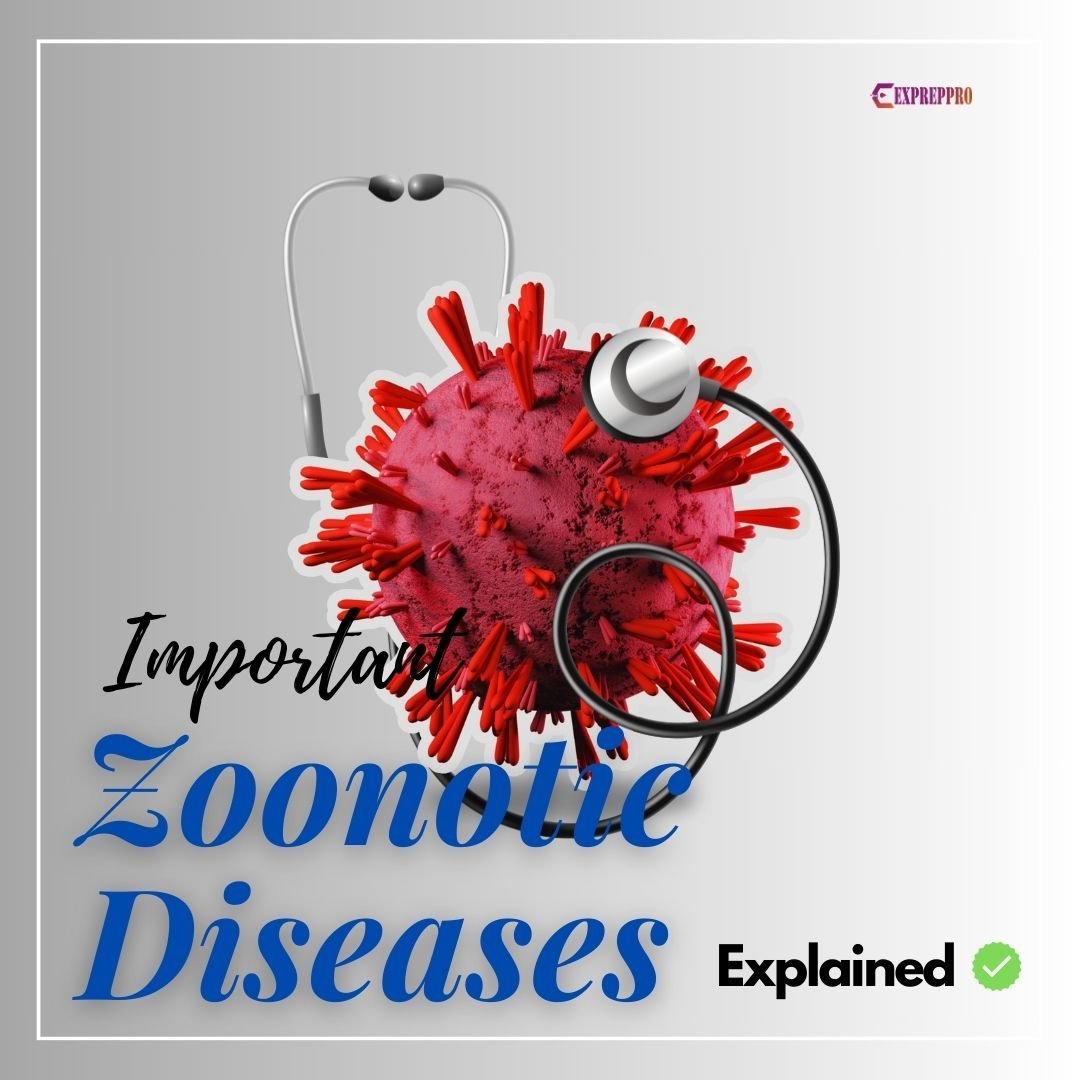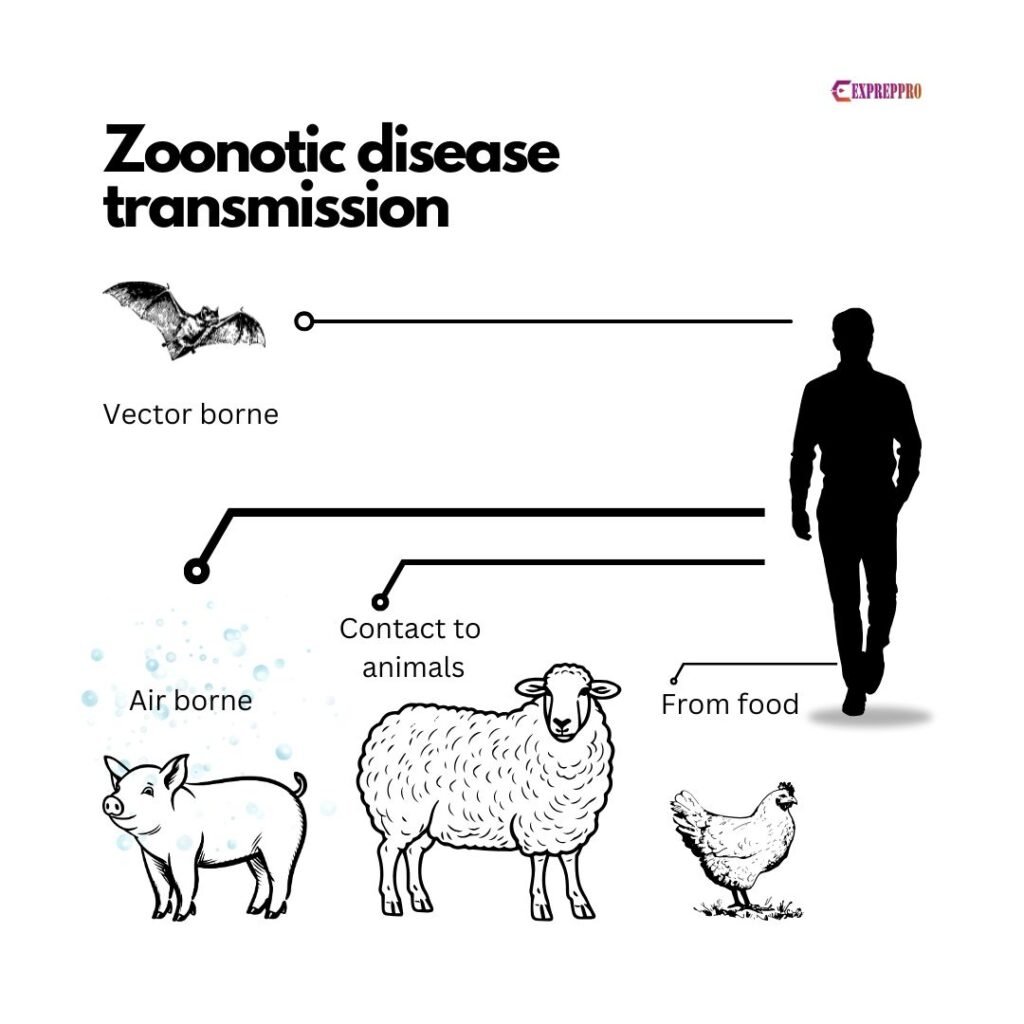
Zoonotic diseases are infections that can be transmitted from animals to humans. These diseases can significantly impact public health, animal health, and the economy. Here are some brief notes on critical zoonotic diseases.

1.PLAGUE
The Plague is caused by the bacterium Yersinia pestis. The Yersinia genus contains over thirteen species. Most of them do not or rarely cause disease.
Out of thirteen, three species cause disease.
- Y. enterocolitica
- Y. pseudotuberculosis
Both can cause food-borne disease.
The third one is the most important one. Y.pestis, a gram-negative bacteria, can cause the notorious Plague.
Y.pestis can move when grown at 77 degrees Fahrenheit or 25 degrees Celsius, but not in the human body.
The Plague originated in China, and Europe named this disease the Black Death. Later, the name “Black Death” became the synonym of Plague.
Three different types of Plague.
1.Bubonic Plague-
Infected by the bite of an infected flea and, Y.pestis invades the lymph system.
The patient will have a high temperature of up to 106 Fahrenheit or 41 degrees Celsius.
2.Septicemic Plague
It Invades the bloodstream, and symptoms occur in two to six days.
Fever, gastrointestinal problems like nausea, diarrhoea, abdominal pain, and internal haemorrhage are the main symptoms.
May progress to coma, septic shock and meningitis. If left untreated, the condition will result in death.
3.Pneumonic Plague
First, the infection will affect the lungs. It’s the least common but deadliest.
Coughing of blood is a symptom if untreated; the mortality rate is a hundred per cent.
What are the susceptible hosts of the Plague?
- Woodrats
- Chipmunk
- Ground Squirrels
- Prairie Dogs
- Marmots are the hosts of the Plague
Wild carnivores can become infected by eating other infected animals.
Coyotes, Foxes, Raccoon, Skunk, and Ferret have some resistance to y. pestis and often do not die from it. Bob Cat, Cougars are highly susceptible. Voles, Short-tailed rodents that eat grass, can serve as a reservoir host for Y.pestis.
TRANSMISSION
Usually, it transmits from host to human, and person-to-person transmission is rare.
The Plague is challenging to diagnose because the first symptoms often mimic those caused by the flu. It is not fatal in dogs, but in the case of cats, forty per cent die.
TREATMENT
Plague can be effectively treated with antibiotics like Streptomycin and Tetracycline. The intramuscular vaccine for the Plague is used in the USA. The current plague vaccine is based on formalin-killed whole Y. pestis bacterial cells.
N N diethyl-m-toluamide (DEET) can be used to repeal the host fleas.
2.BRUCELLOSIS
The disease Brucellosis is caused by the bacteria genus Brucella, and Brucella melitensis is the most prevalent species. It is a rod-shaped gram-negative bacteria which exists in small clusters or alone.
They are not capable of movements.
Four species can infect humans.
- B.melitensis
- B.suis
- B.abortus
- B.canis
(These four are listed in descending order of importance.)
B.ovis is found in semen, and B.bortus can survive 114 days in freshwater, 66 days in cool, wet soil, and 53 days in maure.
David Bruce, a British doctor, isolated Brucella in 1887.
SYMPTOMS
Fever, Sweating, Fatigue, Muscle pain, Backaches, Headaches etc.
B.melitensis affects the nervous system, and less than one per cent die due to this infection. It can affect any part of the human body.
How does brucellosis spread to humans?
- It can enter through the skin.
- Unpasteurized milk.
- Breastfeeding from contacted mothers.
TREATMENT
Antibiotics like Doxycycline and Rifampicin can be used to treat Brucellosis. If pathogens evade the CNS, then the treatment with medicines will become limited due to the blood-brain barrier.
B.melitensis and B.suis are the most virulent ones.
Brucella vaccine provides immunity for 6 to 12 months but sometimes may get hypersensitive.
RB51 or B.abortus strain 19-based cattle vaccine and Rev-51 or B.melitensis-based sheep vaccine are the important vaccines available for use in livestock. RB-51 will not give false positives during testing after vaccination.
3.TUBERCULOSIS
Tuberculosis is caused by genes mycobacterium. It is an aerobic, gram-positive bacteria with a waxy shell and a high concentration of lipids. This coat provides protection and helps them to survive outside, even in a dry state.
M.bovis affects cattle, deer, and elk and not humans. M.africanum and M.cnetti are responsible for half of the cases in Africa. M.microti will affect people with weak immunity. Robert Koch first isolated T.B., and for this, awarded the 1905 Nobel Prize.
TREATMENT
Antibiotic Streptomycin is widely used to treat Tuberculosis. Other drugs include Isoniazid and Rifampin.
SYMPTOMS
Mostly, it will be asymptomatic, but about ten per cent show T.B.
Chest X-ray granulomas are not unique to Tuberculosis patients.
When M. tuberculosis spreads to other organs besides the lungs, it is called disseminated T.B. Children are at greater risk than adults.
Latent infection may develop Tuberculosis after the initial infection.
Unexplained weight loss, night sweats, and cough are the other symptoms of T.B.
TRANSMISSION
The following organisms act as a reserve of M.bovis.
- Brush-tailed possum of NewZealand
- White-tailed deer of the USA
- European Badger of the U.K
TREATMENT
Medicines like Ethambutol and Pyrazinamide are used to treat Tuberculosis. Usually, the treatment will continue for six to seven months.
Cocktail drugs are more effective against M. tuberculosis. It is less likely to develop drug resistance.
How is Tuberculosis transmitted to humans?
- Pathogen inhaled
- Contaminated food and water
- Unpasteurized milk and cheese
4.TULAREMIA
It is caused by the bacterium Francisella tularensis and is named after Tulare County because it was first discovered there. The causative agent is a rod-shaped, aerobic, gram-negative bacterium.
Another causative agent, F.philomiragia, is present in salt waters of the Atlantic and Mediterranean seas.
There are four subspecies.
- F.tularensis tularensis: It causes type A disease and is the most infectious human pathogen in the world. Inhalation of 25 bacterial cells is sufficient to make humans sick.
- F.tularensis holarctica: It causes type B disease and is found in the Northern Hemisphere. Holarctica is less virulent than tularensis.
- F.tularensis novicida: it was first isolated from a Utha water sample. Even though low virulent, it can cause disease in weak immune people. It is reported in countries like the USA, Canada, Australia, Spain etc.
- F.tularensis mediasiatica: It shows virulence similar to F.tularensis holarctica and is reported in countries like Kazakhstan and Turkmenistan.
Rocky mountain tick can spread Tularemia.
The pathogen can survive up to 12 weeks in stored feed, 14 weeks in water or mud and 26 weeks in straw.
Type B usually increases during wars and natural disasters.
DEET is used to repel insects that spread disease.
5.LEPROSY
Leprosy is caused by Mycobacterium leprae. M.lepromatosis also cause leprosy disease.
It is a rod-shaped organism with a waxy membrane. It can’t survive outside and cannot be cultured in the lab. It mainly affects skin and nerves; patches may be pale, reddish, or copper, blur vision, eye discharge, or loss of sensation are the main symptoms.
Leprosy needs a long incubation period of 3 years. Most people are resistant to leprosy. The genes responsible for this resistance were located on the sixth chromosome.
Other than Humans, Nine-banded Armadillos are the only known animals that serve as a reservoir host for M.leprare because they have low body temperatures of 90 Fahrenheit to 95 Fahrenheit.
M.leprae cannot maintain itself in any primate species except for humans.
TRANSMISSION
- Contact from infected persons
- Inhale nasal droplets
- Skin-to-skin contact
TREATMENT
Six months of treatment with Rifampicin and Dapsone is the common way to counter this disease. Clofazimine is also used. After one month of treatment, patients are no longer in danger of spreading the disease.
6.ANTHRAX
Anthrax is caused by Bacillus anthracis. It is a small, rod-shaped, gram-positive bacteria. B.anthracis is not capable of movement. This disease can affect mammal herbivores and can infect all warm-blooded animals.
Spores of Anthrax can affect the new organisms and can survive until they get a suitable environment, like 46 Fahrenheit to 113 Fahrenheit, PH 5 to 9, and the presence of amino acids. Spores survival is enhanced in dry, alkaline, calcium-rich soil and will germinate in less than 16 minutes when exposed to factors like L-alanine and ribosides.
Pigs are more resistant to this disease than other livestock. Survived animals like Bisons carry antibodies against this disease. Carnivores are more resistant than herbivores to Anthrax.
TRANSMISSION
B.antracis can be spread from infected to healthy by Aedes aegypti and Aedes taeniorhynchus, houseflies (Tabanus rubidus), and stable flies (Stomoxys calcitrans).
TREATMENT
Antibiotics like Penicillin and Amoxicillin are used for treatment. Animal antibiotics like Sodium benzylpenicillin and benethamine penicillin are used to treat livestock. Usually, live stocks are vaccinated to protect against Anthrax.
In the case of Anthrax, spore formation requires oxygen, so an autopsy should be avoided if possible. The carcass should be buried using a solution of 10 per cent Formaldehyde.



